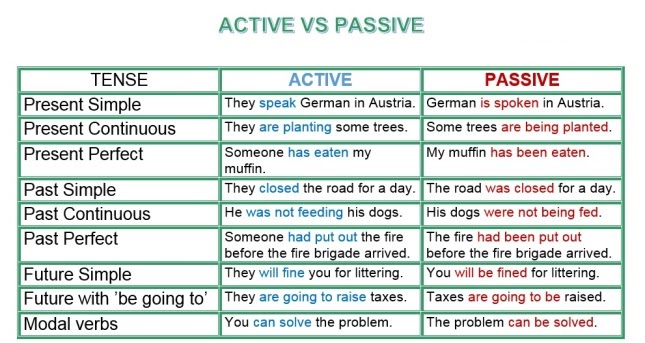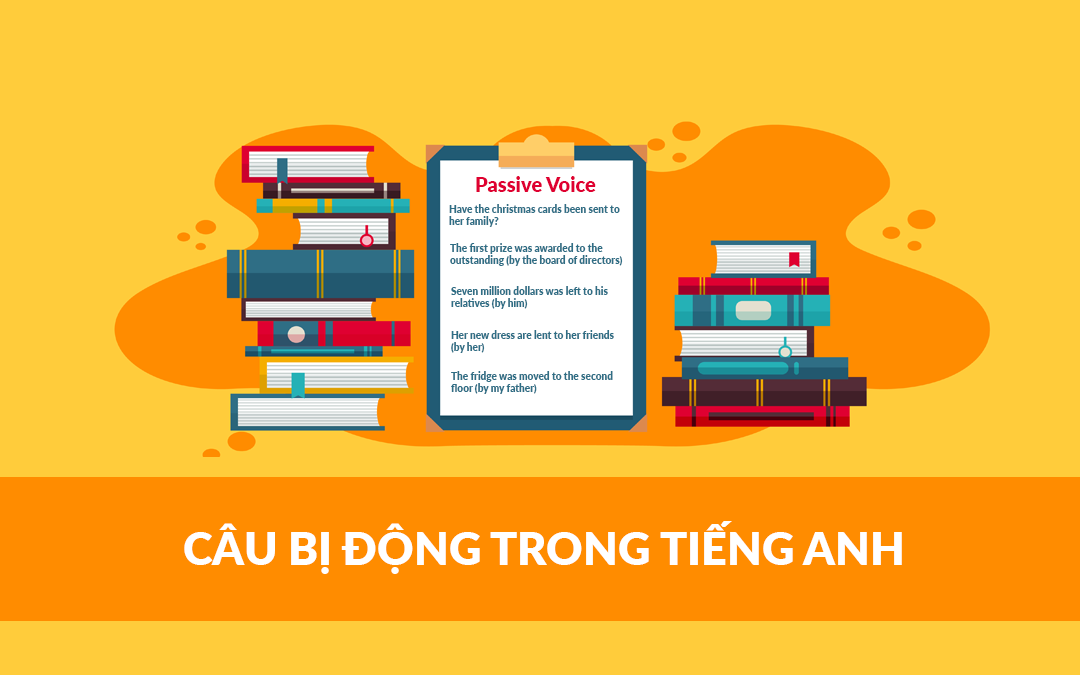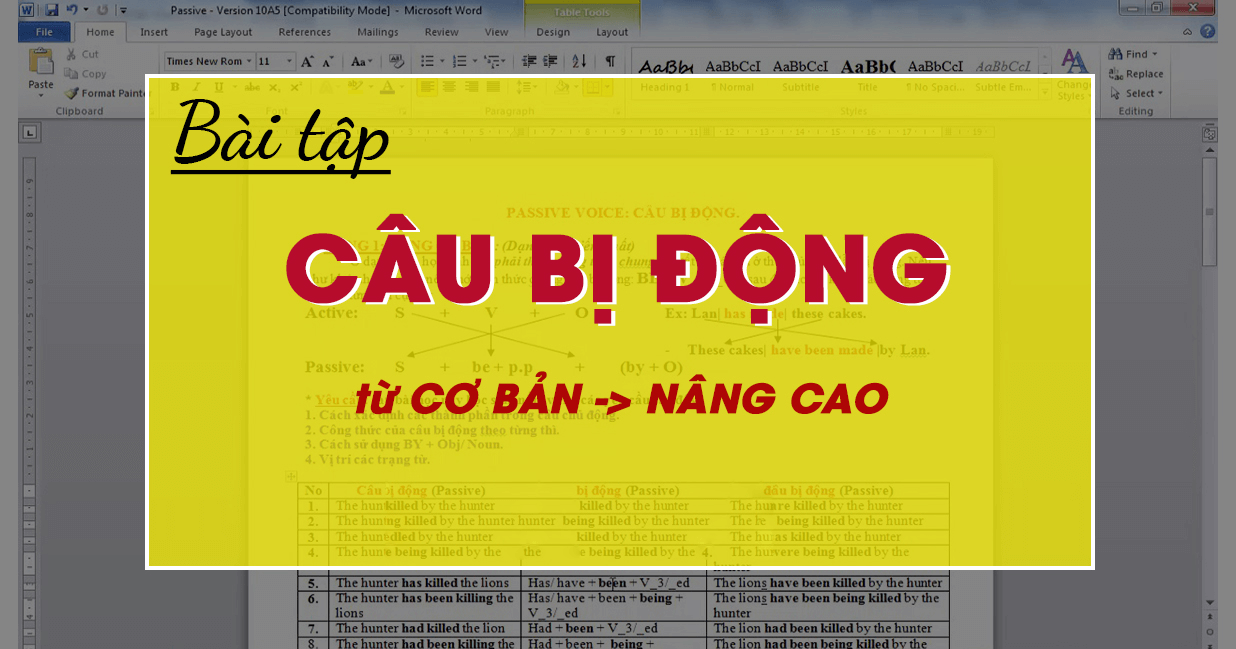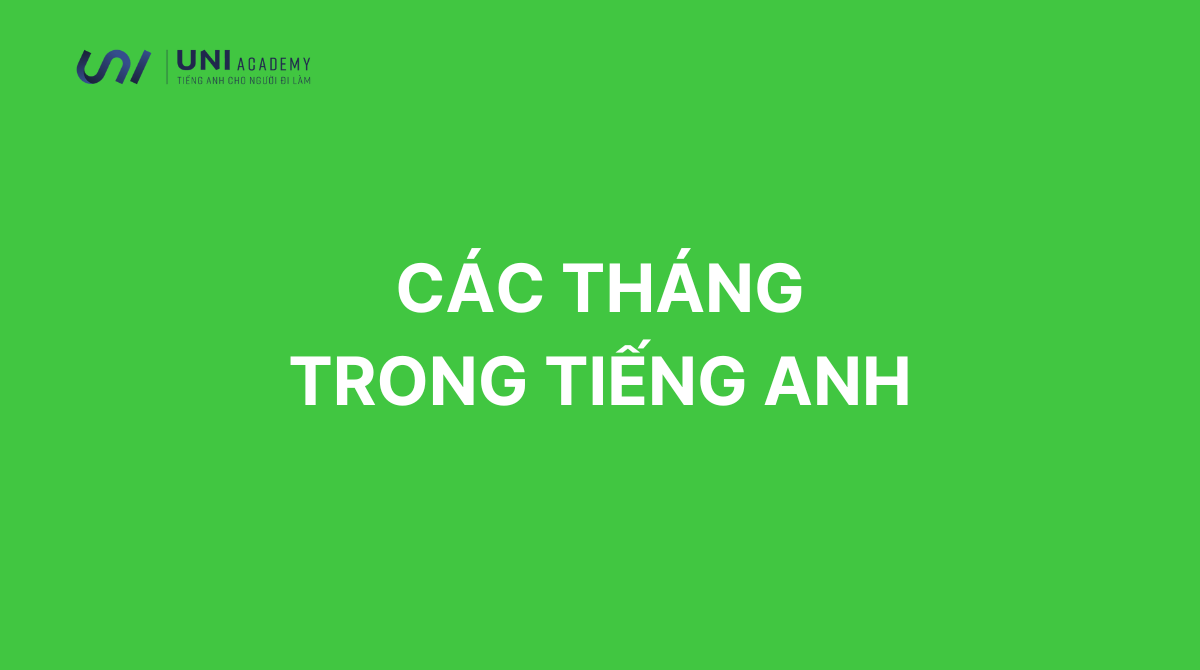Câu bị động (Passive Voice) là một trong những điểm ngữ pháp thú vị khi học tiếng Anh. Vậy câu bị động là gì? Cách sử dụng nó ra sao?
Trong quá trình học tiếng Anh, bạn sẽ không ít lần phải sử dụng câu bị động. Bài viết sau sẽ trình bày những nội dung cơ bản nhất về câu bị động.
Nội dung chính
1. Định nghĩa câu bị động
Câu bị động (Passive Voice) là câu mà chủ ngữ là người hay vật chịu tác động của hành động, được sử dụng để nhấn mạnh đến đối tượng chịu tác động của hành động đó. Thì của câu bị động phải tuân theo thì của câu chủ động.
2. Cấu trúc câu bị động
Câu chủ động: Subject + Verb + Object
Câu bị động: Subject + Verb + By Object
Ví dụ: My mother is washing apples in the yard. (Mẹ tôi đang rửa táo ở ngoài sân.) –> Apples are being washed in the yard by my mother. (Táo đang được rửa ở ngoài sân bởi mẹ tôi.)
3. Các bước chuyển câu chủ động sang bị động trong thì tiếng Anh

3.1 Các bước chuyển đổi sang câu bị động
Việc đầu tiên mà bạn cần phải làm đó là xác định tân ngữ trong câu chủ động đồng thời chuyển thành chủ ngữ cho câu bị động.
Sau đó, hãy xác định thì trong câu chủ động rồi bắt đầu chuyển động từ về thể bị động, chuyển động từ thành dạng “tobe + Ved/P2” cũng như chia động từ “tobe” theo đúng thì của câu chủ động, giữ nguyên cách chia dạng số ít, số nhiều theo chủ ngữ.
Cuối cùng, nếu chủ ngữ trong câu chủ động xác định thì hãy chuyển thành tân ngữ trong câu bị động đồng thời thêm “by” phía trước. Các chủ ngữ không xác định thì có thể bỏ qua, ví dụ them, people…
Ví dụ: I planted a flower in the garden. (Tôi đã trồng một cây hoa ở trong vườn.) –> A flower was planted in the garden (by me). (Một cây hoa được trồng ở trong vườn (bởi tôi).)
3.2 Cấu trúc bị động với các thì trong tiếng Anh
| Thì | Câu chủ động | Câu bị động |
| Hiện tại đơn | S + V(s/es) + O. Ví dụ: Jane buys oranges in the supermarket. Jane mua cam ở siêu thị | S + am/ is/ are + P2 + by O. Ví dụ: Oranges are bought in the supermarket by Jane. Cam được mua ở siêu thị bởi Jane |
| Hiện tại tiếp diễn | S + am/ is/ are + V-ing + O. Ví dụ: Jane is buying oranges in the supermarket. | S + am/is/are + being + P2 + by O. Ví dụ: Oranges are being bought in the supermarket by Jane. |
| Hiện tại hoàn thành | S + have/has + P2 + O. Vs dụ: Jane has bought oranges in the supermarket. | S + have/has + been + P2 + by O. Ví dụ: Oranges have been bought in the supermarket by Jane. |
| Quá khứ đơn | S + Ved + O. Ví dụ: Jane bought oranges in the supermarket. | S + was/were + P2 + by O. Ví dụ: Oranges were bought in the supermarket by Jane. |
| Quá khứ tiếp diễn | S + was/were + V-ing + O. Ví dụ: Jane was buying oranges in the supermarket. | S + was/were + being + P2 + by O. Ví dụ: Oranges were being bought in the supermarket by Jane. |
| Quá khứ hoàn thành | S + had + P2 + O. Ví dụ: Jane had bought oranges in the supermarket. | S + had + been + P2 + by O. Ví dụ: Oranges had been bought in the supermarket by Jane. |
| Tương lai đơn | S + will + V-infi + O. Ví dụ: Jane will buy oranges in the supermarket. | S + will + be + P2 + by O. Ví dụ: Oranges will be bought in the supermarket by Jane. |
| Tương lai hoàn thành | S + will + have + P2 + O. Ví dụ: Jane will have bought oranges in the supermarket. | S + will + have + been + P2 + by O. Ví dụ: Oranges will have been bought in the supermarket by Jane. |
| Tương lai gần | S + am/is/are going to + V-infi + O. Ví dụ: Jane is going to buy oranges in the supermarket. | S + am/is/are going to + be + P2+ by O. Ví dụ: Oranges are going to be bought in the supermarket by Jane. |
| Động từ khuyết thiếu | S + ĐTKT + V-infi + O. Ví dụ: Jane should buy oranges in the supermarket. | S + ĐTKT + be + P2 + by O. Ví dụ: Oranges should be bought in the supermarket by Jane. |
3.3 Một số lưu ý khi chuyển sang câu bị động trong tiếng Anh
Như bạn thấy câu bị động được chuyển từ câu chủ động sang vì vậy rất dễ gây nhầm lẫn khi bạn chia động từ cũng như xác định chủ ngữ chính, vậy nên khi chuyển sang câu bị động hãy chú ý một chút những phần sau nhé:
Nội động từ không dùng ở dạng bị động
Ví dụ: Cry, die, arrive, disappear, wait, hurt… Jane’s foot hurts
Trường hợp trong câu chủ động có 2 tân ngữ
Các bạn có thể chọn một trong hai chủ ngữ làm chủ ngữ chính cho câu bị động (ưu tiên tân ngữ chỉ người) hay có thể chuyển thành 2 câu bị động.
S + V + Oi + Od
- Oi (indirect object): tân ngữ gián tiếp
- Od (direct object): tân ngữ trực tiếp
=> Chuyển sang câu bị động sẽ có 2 trường hợp sau:
TH1: Lấy tân ngữ gián tiếp lên làm chủ ngữ cho câu bị động
S + be + P2 + Od
TH2: Lấy tân ngữ trực tiếp lên làm chủ ngữ cho câu bị động
S + be + P2 + giới từ + Oi
Ví dụ: He gave me a banana yesterday. (Me là tân ngữ gián tiếp còn an apple là tân ngữ trực tiếp)
=> Bị động:
- TH1: I was given a banana yesterday.
- TH2: A banana was given to me yesterday.
Ví dụ: Someone broke the mirror of his motorbike. → The mirror of his motorbike was broken.
Trong câu chủ động có trạng ngữ chỉ nơi chốn, khi chuyển sang câu bị động thì bạn phải đặt trạng ngữ chỉ nơi chốn trước by + tân ngữ.
Ví dụ: Jin bought oranges at the market. → Oranges were bought at the market by Jin.
Đối với những câu chủ động có trạng ngữ chỉ thời gian, khi chúng ta chuyển sang câu bị động thì đặt trạng ngữ chỉ thời gian sau by + tân ngữ.
Ví dụ: Jane used the computer ten hours ago. → The computer was used by Jane ten hours ago.
Nếu câu chủ động có cả trạng ngữ chỉ nơi chốn và trạng ngữ chỉ thời gian, khi chuyển sang câu bị động thì tuân theo quy tắc:
S + be + Ved/P2 + địa điểm + by + tân ngữ + thời gian
Ví dụ: Ms.Lan threw the garbage in front of my house last night. → The garbage was thrown in front of my house by Ms.Lan last night.
Khi chủ ngữ trong câu chủ động là phủ định như no one, nobody, none of… Thì khi chuyển sang câu bị động, ta chia động từ bị động ở dạng phủ định.
Ví dụ: No one can wear this blue dress. → This blue dress cannot be worn.
Trong 1 vài trường hợp to be/to get + P2 sẽ không mang nghĩa bị động khi được dùng để:
Chỉ tình huống, trạng thái mà chủ ngữ trong câu đang gặp phải.
Ví dụ: Adam lost his wallet at the library yesterday.
Chỉ việc chủ ngữ trong câu tự làm hành động.
Ví dụ: My mother gets dressed very quickly.
Mọi sự biến đổi về thời cũng như thể trong câu đều nhằm vào động từ tobe, còn phân từ hai thì giữ nguyên.
To be made of: Được làm bằng (chất liệu làm nên vật).
Ví dụ: This table is made of wood.
To be made from: Được làm ra từ (nguyên vật liệu bị biến đổi khỏi trạng thái ban đầu để làm nên vật.)
Ví dụ: This chair is made from wood
To be made out of: Được làm bằng (quá trình làm ra vật).
Ví dụ: This egg tart was made out of flour, butter, sugar, eggs and milk.
To be made with: Được làm với (chỉ một trong số nhiều chất liệu làm nên vật).
Ví dụ: This fish soup tastes good because it was made with a lot of spices.
4. Một số dạng trong câu bị động tiếng Anh
4.1 Câu bị động với các động từ có 2 tân ngữ như: Give, lend, send, show, buy, make, get, … Thì ta sẽ có 2 câu bị động
Ví dụ:
- He sends his relative a letter. → His relative was sent a letter.
- A letter was sent to his relative
4.2 Câu bị động có động từ tường thuật như: Assume, think, consider, know, believe, say, suppose, suspect, rumour, declare, feel, find, know, report,…
S: chủ ngữ; S’: Chủ ngữ bị động
O: Tân ngữ; O’: Tân ngữ bị động
S + V + that + S’ + V’ + O …
- => Cách 1: S + be + Ved/P2 + to V’
- => Cách 2: It + be + Ved/P2 + that + S’ + V’
Ví dụ:
People say that Adam is very rich.
- → Adam is said to be very rich.
- → It’s said that Adam is very rich.
4.3 Khi câu chủ động là câu nhờ vả như: Have, get, make
Have
S + have + Sb + V + O … –> S + have + O + P2 + (by Sb).
Ví dụ: Marie has her daughter buy a cup of coffee. → Marie has a cup of coffee bought by her daughter.
Make
S + make … + Sb + V + O … => Sb + be + made + to V + O …
Ví dụ: She made me work hard. → I was made to work hard.
Get
S + get + Sb + to V + O… –> S + get + O + to be + P2 (by Sb)
Ví dụ: Julie gets her husband to clean the kitchen for her. → Julie gets the kitchen cleaned by her husband.
4.4 Khi câu chủ động là câu hỏi: Thể bị động của câu hỏi Yes/No
Do/does + S + V-infi + O …? => Am/ is/ are + S’ + Ved/P2 + (by O)?
Ví dụ: Do you clean your classroom? → Is your classroom cleaned (by you)?
Did + S + V-infi + O…? =>Was/were + S’ + Ved/P2 + by + …?
Ví dụ: Can you bring your workbook to my desk? → Can your workbook be brought to my desk?
Modal verbs + S + V-infi + O + …? => Modal verbs + S’ + be + Ved/P2 + by + O’?
Ví dụ: Can you move the table? → Can the table be moved?
Have/has/had + S + Ved/P2 + O + …? => Have/ has/ had + S’ + been + Ved/P2 + by + O’?
Ví dụ: Has she done her homework? → Has her homework been done (by her)?
4.5 Câu bị động với các động từ chỉ quan điểm, ý kiến như: Think/ say/ suppose/ believe/ consider/ report…
Ví dụ:
People think she bought the flowers in the opposite store.
- → It is thought that she bought the flowers in the opposite store.
- → She is thought to have bought the flowers in the opposite store.
4.6 Câu bị động với các động từ chỉ giác quan như: see, hear, watch, look, notice,….
S + P2 + Sb + Ving. (nhìn/ xem/ nghe… ai đó đang làm gì)
Diễn tả hành động đang xảy ra bị 1 hành động khác xen vào hoặc việc ai đó chứng kiến người khác làm gì và chỉ thấy 1 phần của hành động.
Ví dụ: He watched them playing basketball. → They were being watched playing basketball.
S + P2 + Sb + V. (nhìn/ xem/ nghe… ai đó làm gì)
Ai đó chứng kiến người khác làm gì từ đầu đến cuối.
Ví dụ: I heard her cry. → She was heard crying.
4.7 Khi câu chủ động là câu mệnh lệnh
Khẳng định:
V + O Let + O + be + P2
Phủ định:
Don’t + V + O Don’t let + O + be + P2
Ví dụ:
- Do the exercise! → Let the exercise be done!
- Don’t leave her alone! → Don’t let her be left alone!
Câu mệnh lệnh chủ động cũng có thể chuyển thành bị động với SHOULD trong một số tình huống:
Ví dụ: Don’t use the telephone in case it breaks down. –> The telephone shouldn’t be used in case it breaks down.
5. Một số cấu trúc câu bị động dạng đặc biệt thường gặp

5.1. Chuyển câu chủ động có sử dụng to-V thành bị động: S + V + Sb + to V + O
Cách 1: Nếu tân ngữ sau to V trong câu chủ động cũng chính là chủ ngữ trong câu bị động:
S + V + to be + P2 + (by Sb)
Ví dụ: I want you to teach me. –> I want to be taught by you.
Cách 2: Nếu tân ngữ sau to V trong câu chủ động khác với chủ ngữ trong câu bị động:
S + V + O + to be + P2 + (by Sb)
Ví dụ: I want him to repair my car. –> I want my car to be repaired by him.
Cách 3: Có thể dùng Sb trong câu chủ động làm Chủ ngữ của câu bị động:
Sb + be + P2 + to V + O
Ví dụ: People don’t expect the police to find out the stolen money. –> The police aren’t expected to find out the stolen money.
5.2. Cấu trúc: S + V1 + V-ing + O + …
=> S + V + (that) + O + should be + P2 + …
Ví dụ: She suggests drinking wine at the party. –> She suggests that wine should be drunk at the party.
5.3. Cấu trúc: S + V1 + Sb + V-ing + O
=> S + V + being + P2 + O.
Ví dụ: She remembers people taking her to the amusement park. -> She remembers being taken to the amusement park.
5.4. Chuyển câu chủ động dùng động từ nguyên thể không có to sau các V chỉ giác quan thành câu bị động, đổi V thành to V khi chuyển sang bị động
S + see / taste/ watch / hear / look / catch … + Sb + V + O. => S + be + seen / tasted/ watched / heard / looked / caught … + to V + O.
Ví dụ: I sometimes see him go out. -> He is sometimes seen to go out.
5.5. Chuyển câu chủ động có V-ing sau các V chỉ giác quan sang bị động, khi chuyển sang bị động, V-ing vẫn giữ nguyên là V-ing:
S + see / taste/ watch / hear / look / catch … + Sb + V-ing + O. => S + be + seen / tasted/ watched / heard / looked / caught …+ V-ing + O.
Ví dụ: I see him bathing her dog now. -> He is seen bathing her dog now. We heard her singing loudly .
5.6. Cấu trúc bị động với câu giả định
It + be + adj + to V + O => It + be + adj + for + O + to be + P2 ….
Ví dụ: It’s very difficult to study Japanese. -> It’s very difficult for Japanese to be studied.
5.7. Cấu trúc: It + be + my/ your/ his/ her/ their/ our… + duty + to-V + O
=> I/ You/ He/ She/ They/ We + be + supposed + to V + O
Ví dụ: It’s their duty to do this job. –> They are supposed to do this job.
5.8. Mẫu câu chủ động với “to let” khi chuyển sang bị động nên được thay thế bằng dạng bị động của ALLOW + to V
S + let + … + V => Sb + be + allowed + to V …
Ví dụ: She let him enter the room. –> He was allowed to enter the room.
5.9. Cấu trúc: Sb + need / deserve + to V + Sth + …
=> Sth + need/ deserve + V-ing …
Ví dụ: We need to water the flowers everyday. –> The flowers need watering everyday.
6. Bài tập câu bị động

Exercise 1: Complete the sentences using one of these verbs in the correct form, present or past
Example: Many accidents are caused by dangerous driving.
- Cheese _____________________________ from milk.
- The roof of the building __________________________________ in a storm few days ago.
- You __________________________________ to the wedding. Why didn’t you go?
- A cinema is a place where films _________________________________.
- In the United States, elections for president _____________________________ every four years.
- Originally the book ______________________ in Spanish, and a few years ago it __________________ into English.
- Although we were driving fast, we __________________________ by a lot of other cars.
- You can’t see the house from the road. It _______________________________ by trees.
Exercise 2: Put the verb in the correct form, present simple or past simple, by using passive structures
Example: It is a big factory. Five hundred people are employed(employ) there.
- How much of the earth’s surface ______________________ (cover) by water?
- The park gates ______________________ (lock) at 6.30 p.m. every evening.
- The letter __________________ (send) a week ago and it __________________ (arrive) yesterday.
- While I was on holiday, my camera _____________________ (steal) from my hotel room.
- The company is not independent. It ____________________ (own) by a much larger company.
- This room __________________________ (clean) every day.
- How much money ________________________ (steal) in the robbery?
Exercise 3: Read the model answer to the following essay question. Choose the correct form of the verb.
The increase in the number of privately owned cars is having a negative impact on both our towns and the environment.
What can individuals and the government do to reduce this problem?
The number of people who own a car (1) is rising / is being risen year upon year, but this is causing both traffic congestion and air pollution. I believe this issue (2) will only resolve / will only be resolved if individual car owners make an effort to share transport and governments improve public transport systems.
The first way to address the problem is for individual citizens to make an effort (3) to use / to be used their cars less. Of course, there are times when using a car is unavoidable, like when you have to travel long distances or need to travel during the night, but many times we use our cars for short journeys that could just as easily (4) make / be made on foot. If car owners decided to never drive a distance that they could walk, this would cut down significantly the amount of traffic in our towns and cities. Moreover, when people travel to the same places on a regular basis, such as the office or the gym, they should try to share the trip with a friend or family member. Far too many car journeys today (5) is made / are made with only one person in the vehicle. If everybody carpooled with their colleagues tomorrow, car use (6) could reduce / could be reduced by more than 50% overnight.
There is also a range of ways that the government (7) could be helped / could help alleviate the problem. Firstly, the main reason why people choose to travel by car is the poor public transport service currently (8) is offering / being offered in many cities. There are far too few bus services run even in major cities, and until people can be sure that they will never have to wait more than 10 minutes for a bus, they will choose to drive. The same is true of Metro services, which run well during the day but stop functioning fat too early in the evening to be a viable alternative to cars. In addition, governments (9) should do / should be done more to reward people who drive with one passenger or more in their cars. In Australia, there are special lanes for cars like these, and as these tend to move much more quickly than the regular traffic, more and more people are choosing to carpool every year.
To conclude, only when individuals start sharing cars and governments improve public transport infrastructure, will the problem of increased road traffic (10) solve / be solved.
Đáp án
Exercise 1
- Cheese is made from milk.
- The roof of the building was damaged in a storm a few days ago.
- You were invited to the wedding. Why didn’t you go?
- A cinema is a place where films are shown.
- In the United States, elections for president are held every four years.
- Originally the book was written in Spanish, and a few years ago it was translated into English.
- Although we were driving fast, we were overtaken by a lot of other cars.
- You can’t see the house from the road. It is surrounded by trees.
Exercise 2
- How much of the earth’s surface is covered by water?
- The park gates are locked at 6.30 p.m. every evening.
- The letter was sent a week ago and it arrived yesterday.
- While I was on holiday, my camera was stolen from my hotel room.
- The company is not independent. It is owned by a much larger company.
- This room is cleaned every day.
- How much money is stolen/was stolen in the robbery? (câu này có thể sử dụng cả thì hiện tại đơn và quá khứ đơn, do không mốc rõ thời gian)
Exercise 3
- is rising
- will only be resolved
- to use
- be made
- are made
- could be reduced
- could help
- being offered
- should do
- be solved.
Trên đây là kiến thức bài học về câu bị động trong tiếng Anh. Unia.vn hy vọng sẽ giúp các bạn có thể học tiếng Anh được hiệu quả hơn!






